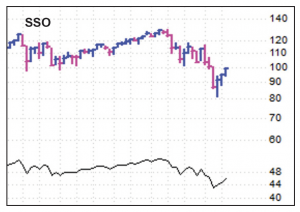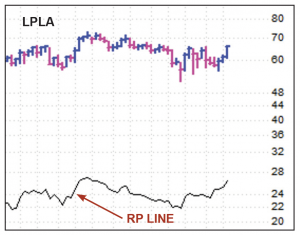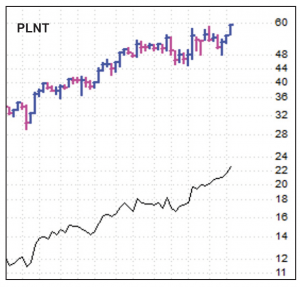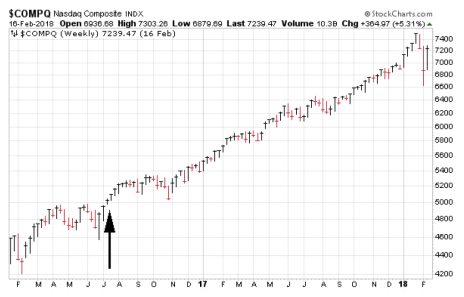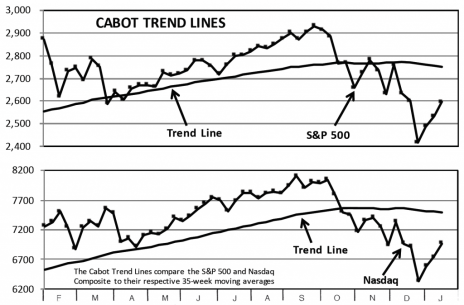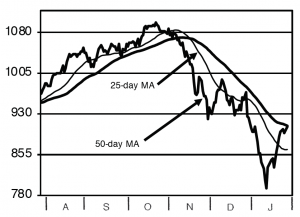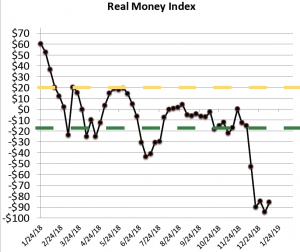The rally off the climactic Christmas Eve low has been very impressive, triggering our 2-to-1 Blastoff Indicator that prompted us to put some money back to work last week. Since then, the action has been encouraging, and our Cabot Tides are close to a new Buy signal. If it comes, we’ll put more of our cash into potential leading names.
Cabot Growth Investor 1411
[premium_html_toc post_id="168815"]
We’re Optimistic
Just three weeks ago the market was on its knees, as the major indexes were down more than 20% from their highs, the average growth stock was in tatters and there were air pockets galore—the final four days of the decline saw the Dow lose nearly 2,000 points!
As we wrote in the last issue, the severity of the decline, which produced historic oversold readings and widespread pessimism, combined with the decent initial bounce off the lows, offered reason for hope that the peak in downside momentum had been reached. But there wasn’t enough positive evidence to start buying. After all, the odds favored lots of hesitation and potholes—if not another leg down—as the market attempted to start a bottoming process.
But, in the market, it’s the unusual that you should pay attention to most—it’s when the market doesn’t follow the “normal” script that it’s really telling you something. And what we saw after the market’s Christmas Eve low certainly qualifies as unusual.
Starting with the first day off the bottom (when the Dow rose more than 1,000 points), the market put on an advance with breadth that was so strong it triggered our 2-to-1 Blastoff Indicator, a rare measure that has historically occurred near major bottoms and led to big gains all during the following year! (See much more about the indicator and its track record on page 6.)
Obviously, no indicator is perfect, but that green light prompted us to begin coming off the sideline last week (buying three half-sized positions), and the action since then has been very constructive, with little in the way of selling pressures (see page 7) and more potential leading stocks either setting up or testing new high ground.
That said, one swallow does not a summer make. With the improved evidence, the worst has probably passed and it’s likely that the next major move is up—but we don’t advise getting aggressive until we see the intermediate-term trend (Cabot Tides) turn up (could happen in a couple of days) and more growth stocks kick into gear.
[highlight_box]WHAT TO DO NOW: In the meantime, we’re optimistic but still practicing patience and following the system. Last week, we bought half-sized positions (5% of the portfolio) in Ciena (CIEN), ProShares Ultra S&P Fund (SSO) and Workday (WDAY). That still leaves us with 67% in cash—enough to withstand a bottom-building process should one occur, but also providing plenty of buying power should this nascent uptrend gather steam.[/highlight_box]
Model Portfolio Update
We’ve been doing a whole lot of watching and waiting since the start of October, but now that the evidence has begun to improve, we’re starting to put money back to work—we added three half-sized positions last week.
As usual, we’re going to move back into the market in stages based on the evidence and if (and how much) it improves. The 2-to-1 Blastoff Indicator (along with historic oversold readings and bearish sentiment in December) provided the impetus to initially put money to work last week. Those additions are off to decent starts, and given the encouraging tone (lack of pullbacks in the overall market) and action among leading stocks, we’re hopeful we’ll be putting more money to work soon.
From here, it’s all about seeing our trend-following indicators (starting with our Cabot Tides) turn green, as well as seeing continued positive action among growth stocks (particularly as earnings season gets started). As always, if we see more positive action, it won’t take us long to get heavily invested—but we won’t rush it, especially with many earnings reports upcoming.
As for individual stocks, so far we’re seeing a bit more “action” in names that are coming off their bottoms than those that are near their peaks. That’s not unusual, though, this early in a new rally—if the sellers really have left the building, we should see more stocks hitting new highs in the near future.
Current Recommendations
BUY—Ciena (CIEN 38)—Ciena was added last week (5% position) for all the reasons we’ve been writing about in recent issues—after a few years of investment and stagnant growth, the company is at the forefront of a handful of hot growth areas in the networking field. That includes its 5G and webscale data center interconnect products (its Waveserver product is a big driver) and its automation software, all of which should push sales and earnings meaningfully higher in the years ahead. (Interestingly, despite the fact that revenues from its largest customer, AT&T, were down last year, revenues grew nicely—a sign that Ciena has diversified away from a sole focus on U.S. telcos.) We also like the fact that, in an easy come/easy go sector like networking, management has a solid three-year outlook (20% earnings growth annually), though Wall Street is thinking that outlook is very conservative; analysts see earnings rising 35% this fiscal year (ending in October) and another 25% next, projections that are bolstered by the firm’s current string of accelerating sales and earnings growth (up 21% and 66% in Q3, respectively). Long story short, the fundamentals are lined up, both industry-wide (spending boom) and with Ciena (leading products), and the chart remains in great shape—not only did CIEN hold up well throughout the market downturn, it was one of the first to move to new highs following the Christmas Eve low. If you don’t own any, we’re OK buying a half-sized position (half your normal amount, dollar-wise) here or on dips of a point or two.
BUY—Five Below (FIVE 120)—Five Below presented at a big retail conference this week, and as usual, updated investors on business trends for the all-important fourth quarter. And the figures were encouraging—total sales for November and December rose nearly 25%, with same-store sales up 4.9%, both figures tracking ahead of earlier estimates. Beyond that, though, management relayed many encouraging facts and figures: The firm expects to open 145-150 new stores this year (19% to 20% expansion in the store count), a bit above its “high-teens” long-term target; new-store productivity remains best-in-class, with recent openings paying back in just eight months (!); the firm is set to remodel about 300 of its stores, expecting a decent payback on that investment (three to four years); toy sales have been encouraging and could be a new growth area going forward; and it may experiment with a “Ten Below” price point on certain items in new categories (like connected home electronics) if it provides great value for the consumer. Long story short, we think the 20%-plus annual growth story is very much intact and that Five Below’s story is as good as it comes in retail. As for the stock, it’s pulled back a bit in recent days, but after the huge rally from its December lows (87 to 123), some hesitation is normal. We’ll stay on Buy if you don’t own any; try to buy on dips of a couple of points.
BUY—ProShares Ultra S&P 500 Fund (SSO 102)—As we wrote in last week’s update, we weren’t planning on buying a stake in a leveraged long index fund while our trend-following market timing indicators were still negative. But we decided to jump into a half-sized position in SSO (about 5% of the portfolio’s value invested) because of the 2-to-1 Blastoff Indicator, which is written about more on page 6. Obviously, no indicator is perfect, and if the market implodes we’ll cut our loss down the road. But the track record of this unique indicator is so good that we thought it best to get started on a position here, with the idea of averaging up should our Cabot Tides turn positive and we develop a decent profit. If for some reason you can’t buy a leveraged long fund, there’s nothing wrong with buying the “regular” tracking fund (SPY in this case); just consider buying a bigger position (since it will be far less volatile on a percentage basis). Also, some have asked why SSO and not QLD (tracking the Nasdaq 100), which often moves faster than the S&P 500. The answer has to do with diversification, as most of our individual stock recommendations tend to track more closely with the Nasdaq. Thus, having a fund that acts a bit differently should offer more balance. That said, we’re not hardcore about it—if you’d rather buy QLD or UWM (tracks the Russell 2000 SmallCap Index), or some combination of the three, there’s nothing wrong with that. The main point is to get a foothold early in what could be a big, sustained advance for the market. If you don’t own any SSO, you can grab a small position here.
BUY—Twilio (TWLO 102)—There weren’t many stocks that held up well during the entire market decline, but TWLO was one of them, and so it’s not surprising to see shares eke out new highs in recent days. Granted, there has been some resistance around 100 in recent days and the volatility of the stock has been extreme; thus, like many names, it wouldn’t surprise us if the stock pulled back a few points (the 50-day line is down around 89) to shake some people out. Obviously, if we see a real implosion while the market continues higher, we’ll rethink our outlook, but right now, the story, numbers and overall chart picture look great. We’ll stay on Buy, though aiming for dips of a couple of points makes sense. The next big event will be earnings, which are due out in just under a month (February 12).
BUY—Workday (WDAY 167)—Workday was the third addition to the portfolio last week; again, we bought a half-sized stake and will buy more if the stock kicks into gear. The firm has always been a well-thought-of company, but we really can’t say it’s been a big leading stock; within the cloud software group, others have usually led the charge. But should this market continue higher, we think WDAY could lead the way this time, partly because of its action (the massive move to new highs before and after earnings in late November was a tell) and partly because the firm’s business is picking up steam as its core human capital management (HCM) offerings grab share and its relatively newer financials management platform picks up some big customers—after a 23% gain last year, analysts see earnings up 27% this year and, as usual, those figures are probably lowballed to some degree. Like most resilient stocks, WDAY initially snapped back nicely and has eased lower in recent days; a continued pullback of a few points would be normal, while an eventual push into the low 170s (and a positive market trend) would likely have us buying more. Right now, we’re sitting tight with our initial shares; if you don’t own any, we’re OK grabbing a starter position on this pullback.
Watch List
Alteryx (AYX 71): Given that we just added WDAY, we might move AYX to our “back burner” watch list—but if Workday fails or we decide to add another software name, Alteryx would probably be our choice due to the firm’s leading position in advanced analytics, a newer field that we think has huge growth ahead of it. Earnings are likely out in mid-February.
Exact Sciences (EXAS 76): Sometimes you have to tip your hat to the market, and EXAS is a case in point—the stock imploded from 84 to 54 in a matter of weeks, knocking us out of our position. But the company has since preannounced great Q4 results, sending shares back toward their highs. A couple of calm weeks would be good to see. Earnings are likely out in early/mid-February.
Okta (OKTA 76): Things can change in a hurry, but at this point, OKTA would be our next addition to the portfolio if things shape up—the stock is extremely strong, growth has continually surprised on the upside and the long-term potential of its identity management solutions remain giant.
PayPal (PYPL 90): PYPL has pushed all the way back near its all-time highs. A pause or pullback would be normal (and probably healthy) at this point and allow the stock to gather strength as it heads into earnings (January 30).
Planet Fitness (PLNT 58): PLNT staged a great-looking volume cluster (five straight big-volume up days), a sign the stock wants to head higher after holding up well during the market decline. See more on page 6.
Tesla (TSLA 347): As we write below, TSLA is back on our watch list as the stock carved out a shallower launching pad during the past few weeks. We still see big earnings on the way this year and beyond.
Zscaler (ZS 45): While OKTA is near the top of our shopping list today, we’re not kicking ZS to the curb quite yet—the stock continues to act well and its new-age cloud-model, cybersecurity platform is gaining customers left and right as it attacks a $17 billion (and growing) opportunity. By the way, ZS and OKTA aren’t competitors—they’ve inked deals to integrate their solutions together, but both broadly address the same sector, so we’ll likely pick one or the other.
Other Stocks of Interest
The stocks below may not be followed in Cabot Growth Investor on a regular basis. They’re intended to present you with ideas for additional investment beyond the Model Portfolio. For our current ratings on these stocks, see Updates on Other Stocks of Interest on the subscriber website or email mike@cabotwealth.com.
LPL Financial (LPLA 70)—The vast majority of our work is bottoms-up (finding unique individual growth stocks that, ideally, are changing the way we work, live or entertain ourselves), but one thing we like to do is look ahead at possible scenarios that could play out in the market and ask ourselves, “If XYZ happens, what sector is likely to do well?” Today, we’re thinking that if the 2-to-1 Blastoff Indicator leads to a healthy, sustained bull move, one group to watch are Bull Market stocks, and the most resilient of that bunch today is LPL Financial, a leader in retail financial advice and the U.S.’ largest independent broker-dealer. Through both organic growth and acquisitions, LPL has been growing excellently in recent quarters (accelerating sales growth and earnings up 80% in Q3) as brokerage and advisory assets have lifted (up 15% year-over-year in Q3) and the company returns cash to shareholders (share count is down 2% from the prior year; annual dividend yield is 1.5%). Of course, the corporate tax cuts and interest rate hikes goosed growth last year despite the wild market, but if the bulls return to Wall Street, it’s likely more men-on-the-street will be seeking advice (and putting money to work in stocks and bonds), which plays into LPL’s hands. The stock formed a higher low in December and has raced to three-month highs; there’s still resistance to chew through, but the relative performance (RP) line is nearing its May peak. Analysts see earnings up 19% this year; earnings are due out January 31.
Tesla (TSLA 347)—We’re still keeping an eye on Tesla, and we’re not the only one. One of our big beefs with the stock in recent years is that it’s been so well followed and in-the-news that it’s hard for the weak hands to really get worn out. Still, fundamentally, we continue to think the firm has transitioned to a “reality” phase; gone are the days of rumors and hope, and here are the days of real, bouyant results. Sales growth has accelerated over the past three quarters (26%, 43% and 129%), earnings were hugely positive in Q3 ($2.90 per share) and Q4 appears to have continued with good vibes; the firm preannounced that production and deliveries both grew 8% sequentially in the quarter, including a 15% sequential bump in Model 3 output. Analysts see earnings of $6.42 per share this year, though if Tesla keeps executing, we think that will prove very conservative. But the reason we’re writing about the stock here is its recent action—after a couple years of wild swings (between 250 to 390, several times), TSLA blasted off on massive volume following Q3 results, and the current pullback has been tamer in terms of both depth (23%) and volume (below average every week). A few more weeks of calm action followed by a breakout above 380 would be very enticing. Earnings are likely out in early February.
Planet Fitness (PLNT 58)—We usually shy away from stocks that have had big, prolonged runs; there’s usually pent-up selling pressure that will be let loose sooner or later. The exception is when a stock does the unusual, like holding up beautifully after a big run, or even showing signs of accumulation during a punishing market downturn. Planet Fitness is a great example, with shares holding relatively firm during the fall and quickly snapping back to new highs on great volume after the calendar flipped. Fundamentally, the company probably has our second favorite cookie-cutter story next to Five Below. Planet’s fitness concept is suited to the mass market (not muscleheads), which, along with a low price ($10 per month to start, though more than half take the higher-priced alternative) attracts members of all different ages and incomes (and more than half of members are female), and that helps produce solid store economics (payback in less than four years) and strong member growth (12.2 million members in Q3, up 16% from a year ago). As for store growth, it had 1,646 at the end of September (nearly all franchised), but has 600 more committed store openings over the next three years and sees the potential for more than 4,000 locations in the U.S. alone. Throw in the fact that the business is tariff- and Amazon-proof and there’s a lot to like. Growth won’t be overly rapid (think 10% to 15% revenue, 20% cash flow, etc.), but should be steady and have a long runway. PLNT is on our Watch List.
A Rare Blastoff Signal
We keep an eye on many market timing indicators, all of which can be divided into three different buckets. The first (and most important) are our primary indicators—those that focus on the price/volume/trend action of the major indexes and leading stocks. Our Cabot Trend Lines and Cabot Tides are included in this bucket, and not surprisingly, those are the indicators we focus on (and trade off of) most.
Then there are secondary indicators—sentiment, overbought/oversold and the like, which can give you a hint as to when to lean against the wind. Our Real Money Index, which tracks money flows into and out of equity funds, is an example.
And then there’s a special category of measures that we call blastoff indicators. In total, we have a handful of these in our arsenal, and the theory behind all of them is simple: When the market shows extremely rare strength over many days or weeks, especially after a good-sized decline, it usually marks a “blastoff” in the market—whereas many investors shy away from such strength (market is overbought, etc.), history tells us that when the market becomes unusually overbought, it usually leads to very good things in the months ahead.
One of these measures with a sterling record is the 2-to-1 Blastoff Indicator, so named because it occurs when the NYSE daily advance-decline line averages twice as many advancers as decliners over a 10-day span. As you can imagine, such power doesn’t occur often—if you exclude overlapping signals (those occurring within six months of each other), there have been just 10 signals since 1960! (Even including overlapping signals, it’s only happened 15 times in 58 years.)
And almost uniformly, these 2-to-1 signals have portended excellent gains for the major indexes. On average, the S&P 500 lifted as much as 12% three months later, nearly 18% within six months, and 25% within a year! Just as important, these signals don’t usually occur near the start of a decent few months—the dates generally line up with major market bottoms that, in some cases, lead to years of gains.
Of course, it’s worth remembering that no indicator can guarantee great results. In fact, the last time this indicator flashed (July 2016—see chart to right), it actually led to some sour results in the near term, with the S&P 500 sagging a few percent into that year’s election. That said, even including that poor start, the S&P 500 rose as much as 14% within a year from the July signal, while the Nasdaq ran ahead by as much as 25% and growth stocks went bananas.
Big picture, the reason we like this (and other) blastoff indicators is because (a) they’re very rare—when you get a signal from them it’s safe to assume a major and sudden positive change in perception has occurred; (b) because the results are so bullish and consistent; and (c) most investors have a hard time embracing them because they’ve just lived through a tough market environment and are being inundated with bad headlines.
Long story short, last week’s green light from the 2-to-1 Blastoff Indicator is a big positive for the market when looking out a few months or even longer. It doesn’t preclude some near-term, news-driven wobbles, but it is a reason to put on your optimist’s hat and to start putting money back to work.
Two-Second Indicator Turnaround
Also showing encouraging action is our Two-Second Indicator (the number of stocks hitting new lows on the NYSE each day), which has made a stunning turnaround of late.
It was just three weeks ago that the number of new lows rose to a near-record—the peak reading was 1,270 on December 20, and that was followed by two more quadruple-digit readings (1,058, 1,256) during the next two trading days as stocks cascaded into their Christmas Eve low. And as the market began to rally, those readings dried up somewhat, which isn’t unusual or particularly telling.
But what is telling is the indicator’s action during the past week or two. The first thing we noticed was that on January 3, the day the major indexes fell 3% after Apple (AAPL) delivered an earnings warning, the Two-Second Indicator saw just 40 new lows—a sign that the selling pressure wasn’t as great as it appeared.
And since then, the action has been extremely impressive. We’ve now seen 10 days in a row of tame readings, all but one of those showing 12 new lows or less. That effectively confirms the message of the 2-to-1 Blastoff Indicator by saying the broad market has quickly returned to health. Obviously, we’ll take it as it comes—should new lows expand again, it would be a yellow flag—but the turnaround is another sign the worst has passed.
Cabot Market Timing Indicators
There’s growing evidence (such as the 2-to-1 Blast-Off Indicator) that the market’s Christmas bottom was the bottom, though a larger bottoming effort is possible. We put some money to work last week and will follow the market’s lead from here.
Cabot Trend Lines: Bearish
Our Cabot Trend Lines have improved, but it’s going to take a bunch more work to turn the longer-term market trend back to the upside. Despite the strong rally, the S&P 500 (by 5.6%) and Nasdaq (by 6.9%) both closed last week well below their respective 35-week lines. There are reasons for optimism that the low is in, but the Trend Lines is still a headwind in the face of the bulls.
Cabot Tides: Bearish
Our Cabot Tides also remain negative, though the next few days could flip the script—all of the major indexes we track are above their 25-day lines (including the S&P 600 SmallCap, shown here), and those moving averages are flattening out; a bit more strength would create a green light. We’ll let you know if it happens, but we don’t anticipate signals—currently, with both trends down, we’re still holding lots of cash.
Cabot Real Money Index: Bullish
Our Real Money Index remains at extreme levels—last week, $9 billion did flow back into equity mutual funds and ETFs, but that pales in comparison to some weekly outflows ($46 billion, $35 billion, $19 billion) seen in recent weeks. Combined with the 2-to-1 Blast-Off Indicator, it’s a good sign the worst of the selloff is in the rearview mirror, though a bottom-building process could still be in the cards.
[premium_html_footer]
Send questions or comments to mike@cabotwealth.com.
Cabot Growth Investor • 176 North Street, Post Office Box 2049, Salem, MA 01970 • www.cabotwealth.com
All Cabot Growth Investor’s buy and sell recommendations are made in issues or updates and posted on the Cabot subscribers’ website. Sell recommendations may also be sent to subscribers as special bulletins via email and the recorded telephone hotline. To calculate the performance of the portfolio, Cabot “buys” and “sells” at the midpoint of the high and low prices of the stock on the day following the recommendation. Cabot’s policy is to sell any stock that shows a loss of 20% in a bull market (15% in a bear market) from our original buy price, calculated using the current closing (not intra-day) price. Subscribers should apply loss limits based on their own personal purchase prices.
Charts show both the stock’s recent trading history and its relative performance (RP) line, which shows you how the stock is performing relative to the S&P 500, a broad-based index. In the ideal case, the stock and its RP line advance in unison. Both tools are key in determining whether to hold or sell.
THE NEXT CABOT GROWTH INVESTOR WILL BE PUBLISHED JANUARY 31, 2019
We appreciate your feedback on this issue. Follow the link below to complete our subscriber satisfaction survey: Go to: www.surveymonkey.com/marketlettersurvey
Neither Cabot Wealth Network nor our employees are compensated by the companies we recommend. Sources of information are believed to be reliable, but are in no way guaranteed to be complete or without error. Recommendations, opinions or suggestions are given with the understanding that subscribers acting on the information assume all risks. © Cabot Wealth Network. Copying and/or electronic transmission of this report is a violation of U.S. copyright law. For the protection of our subscribers, if copyright laws are violated, the subscription will be terminated. To subscribe or for information on our privacy policy, call 978-745-5532, visit www.cabotwealth.com or write to support@cabotwealth.com.
[/premium_html_footer]





